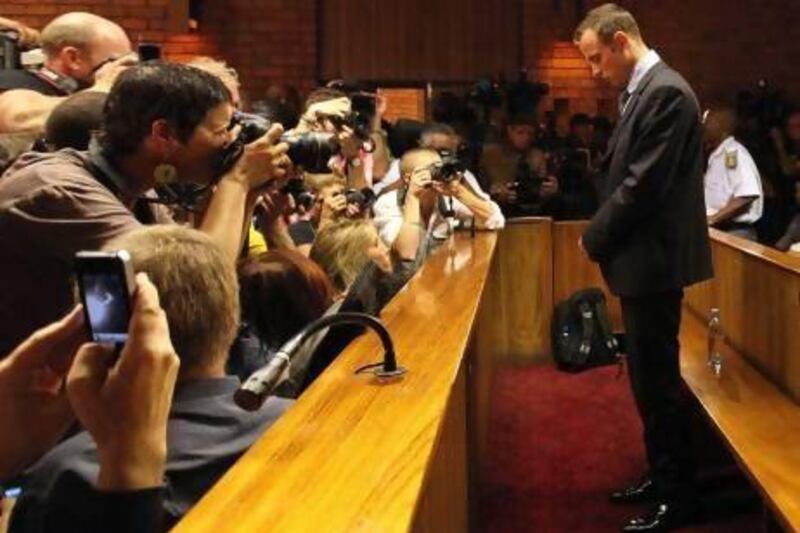JOHANNESBURG // In his Olympic year, Oscar Pistorius steadily became an avid firearms collector, joining a gun-collecting club and purchasing a collection of firearms that included a .500 Magnum pistol dubbed by its manufacturer as "the most powerful production revolver in the world" and a civilian version of a military assault rifle.
At the end of last year, in the first blush of his romance with Reeva Steenkamp, the model he later shot and killed, Mr Pistorius got deeper into his hobby. It was known that Mr Pistorius liked guns but only now, from interviews with other collectors, is it becoming clear the extent to which he became a dedicated firearms aficionado in the 12 months before he shot Steenkamp.
The track star not only applied for licences to own more guns, but actually bought them, too, according to John Beare, vice chairman of the Lowveld Firearm Collectors Association which accepted Mr Pistorius as a paid-up member last April. He and Mr Pistorius were introduced at a Johannesburg hotel in January last year, and it was there that Mr Beare first explained to the athlete how to become a certified collector.
Had he not become a collector, Mr Pistorius would, under South African law, have been limited to a maximum of four firearms for self-defence, of which only two could be handguns.
Carvel Webb, chairman of the National Arms and Ammunition Collectors Confederation of South Africa, an umbrella group for the country's 2,000 approved private collectors including Mr Pistorius, said that in the wake of Steenkamp's killing his group would now verify that Mr Pistorius fulfilled the necessary requirements to be accepted as a collector and a decision in January to allow him to start collecting semi-automatic rifles.
"We will review all of those just to see if we are happy with it," Mr Webb said.
Mr Pistorius made no secret of his passion for firearms. Reporters who visited him at home in Pretoria, the capital, saw the pistol he kept by his bed and was licensed to own. He practised at firing ranges in South Africa and in Europe where he trained for the London Games.
Mr Beare said he twice observed Mr Pistorius shoot at firing ranges and also at a clay-pigeon shoot, but saw nothing to suggest he could be a menace with a gun.
"His safety was good," Mr Beare said. Mr Pistorius said he mistook his girlfriend Steenkamp for a home intruder and shot her while she was in his bathroom toilet, firing through the closed door. Mr Pistorius's licence for the 9mm pistol was issued on September 10, 2010, according to the South African Police Service's National Firearms Centre. It was registered for self-defence.
Prosecutors have charged Mr Pistorius with premeditated murder for killing Steenkamp with three of four shots fired in the early hours of February 14.
Gun collecting is regulated by South Africa's stringent firearms control act. Mr Pistorius had to explain to his collecting association, in writing and in interviews, what types of firearms he wanted to collect and why.
Mr Beare said he and two other association members interviewed Mr Pistorius in June or July last year, shortly before he became the first double-amputee Olympic runner.
"He was still budding [as a collector] at that stage. He had done his research on it and he was interested in American firearms," Mr Beare said.
The association certified Mr Pistorius as a beginner collector, Mr Beare said. Mr Pistorius bought two Smith & Wesson revolvers and three shotguns and sent photos of the firearms and their serial numbers to the association, as required, Mr Beare said.
But Mr Pistorius couldn't take physical possession of his firearms because he didn't have police-issued licences for them. So the weapons were held by a gun dealer for safekeeping, Mr Beare said. Mr Pistorius eventually applied for the licences in January, according to the National Firearms Centre.
The current status of those applications is unclear. Firearms Centre officials said after Mr Pistorius killed Steenkamp that the six licence applications were sent back to a Johannesburg police station to be refilled.
One of his guns, a Vektor .223-calibre rifle, is the closest a civilian can get to the R-series assault rifles used by South Africa's military. For civilian use, the rifle is modified to make it only semi-automatic. Because it is classed as a restricted weapon in South Africa, Mr Pistorius had to upgrade his status from a beginner to a more serious collector.
As part of that upgrading process, Mr Pistorius was interviewed again by his collectors' club in January, Mr Beare said. It accepted the runner's explanation that he wanted to collect weapons linked to South African military history.





